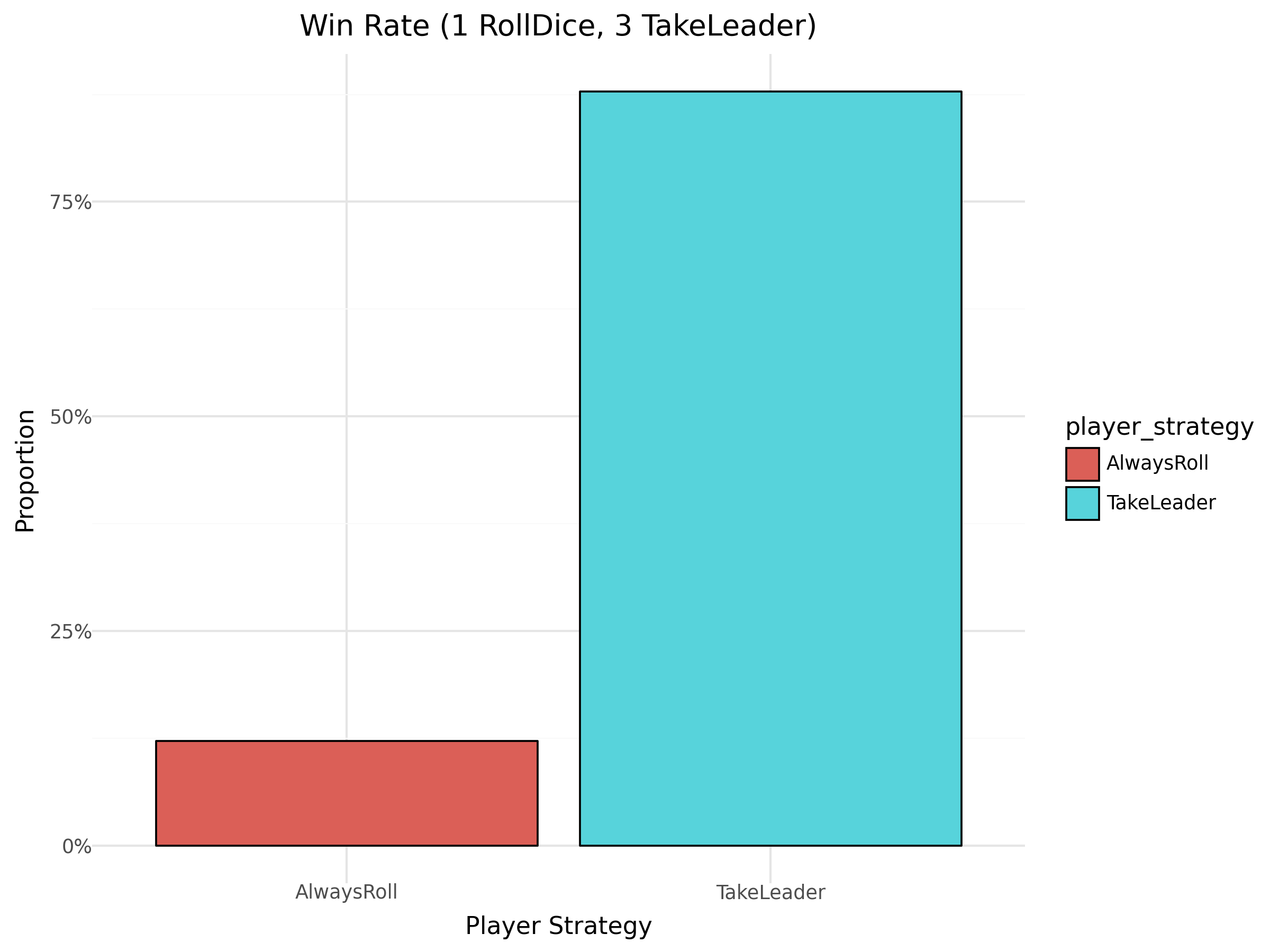This is part 2 in a series about learning the deeper mysteries of Camel Up to prove my dad wrong. If you haven’t read it yet, you can find part 1 here.
Welcome back! I hope you’ve been applying our takeaways from the last deep dive! Today we’re going to turn up the heat and hopefully prove my dad’s favourite strategy wrong. Is rolling the dice a suckers move?
Just cos I’m a good guy, I’ll throw in the answer to another question as well: If you have a resident dice roller on game night, where should you sit to maximize your chances of winning?
To explore this we’re going to take a few different combinations of players with different automated strategies and compare their win rates. From this, we’ll learn how to maximize your chances of winning!
Each combination of strategies below was simulated 100,000 times to generate the win rates and figures. No, I didn’t lock myself in a room to play 100,000 rounds of Camel Up (I bet that’s a novel way to avoid cleaning the kitty litter). I coded up some simulations to get the computer to do the heavy lifting. If you want to see the code for this article, you can find that here.
Remember, the model we’re using is a cut-down version of the rules without boost tiles, end-of-game betting, and crazy camels. See Part 1 for more details.
Agent Strategies
As a refresher, three straightforward strategies have been implemented:
- Roll the Dice (referred to as AlwaysRoll below):
- Just roll the dice every turn. Pretty simple!
- Take Leader’s Betting Tile, Otherwise Roll Dice (referred to as TakeLeader below):
- If any of the betting tiles of the camel that’s currently leading are available, then take one.
- Otherwise default to rolling the dice.
Now that we’ve laid out our strategies, let’s put them head-to-head and see who comes out on top.
Only one person taking tiles
Imagine it: three dice-happy players against one methodical bettor who waits for the perfect moment to snatch that leader’s tile. Who’s winning the camel race now? (Spoiler: It’s not the dice-rollers).

The player taking the betting tiles ran away with the win 90.7% of the time. I guess the dice-rolling crowd just didn’t have luck on their side that other 9.3%.
Only one not taking tiles
What about if you’re the only one not taking tiles? Just constantly rolling the dice? I simulated a game with three methodical players with the TakeLeader betting strategy and one aimless dice roller. How do you think it’ll go?

As you can see, absolutely terribly. These are rookie numbers!
This is unsurprising. The betting tiles have enough upside that usually a player is going to get lucky and get those sweet, sweet coins. Sure, the dice-roller gets a coin here and there, but when the chips are down (or, in this case, the camels), those coins seldom buy you a win.
Is sitting next to the dice roller an advantage?
Now that we know that getting those betting tiles has some serious upside, what should you do if you have a resident dice roller at your table? Can you take advantage of this poor, simple soul?
Here’s a claim that is settled law in our household, but see what you think.
Claim: The player to the left of the dice roller is advantaged most.
Why does this make sense? Well, the simple fact is that when a die gets rolled the information about the game updates. This can drastically change the chances of who wins a leg. The person on the left has the first opportunity to act on the new information. They can crunch the numbers and snatch up the highest-return betting tiles before anyone else gets a chance.
Below I’ve graphed the win rate of each player by their position at the table. Player 2 is our dice roller, and the other three players have the TakeLeader strategy.

Player 3, the player to the left of the dice roller, wins over half the time! You can see that their bar is over double the height of the next player.
Takeaways
What can we take away from all of this for our family games night?
Takeaway 1: Got a dice-happy friend at the table? Park yourself on their left like it’s prime real estate.
You’ll get the first chance to act on the new board state, which gives you a HUGE advantage. Even if you can’t be on their left, just don’t be on their right.
Takeaway 2: Even the simplest betting strategy is better than rolling the dice all day.
Our betting strategy is not particular complicated, just bet on the leader at that point in time. However, from the chart above you can see that everyone following this strategy does better than the dice roller!
What’s Next?
What’s next in the series? We’ll dive into the nitty-gritty of the Python code that brought these simulations to life. Plus, I’ll show you how to harness the power of a graphics card to make those simulations zoom. If you’ve ever dreamed of coding up a true AI agent to take down the table, you won’t want to miss our upcoming exploration into reinforcement learning. Buckle up; it’s going to be a wild ride.
Don’t miss out on the next article, subscribe now to get notified when it drops.
Leave a Reply to How To Beat Your Dad At Camel Up (Interlude – Code Review) – Mr. GrumpyKitten Cancel reply